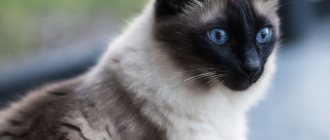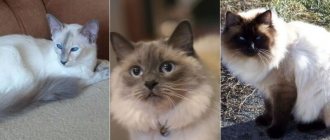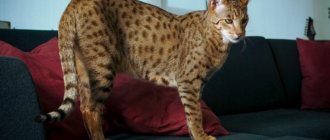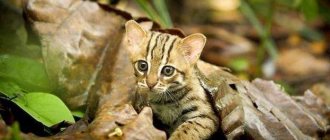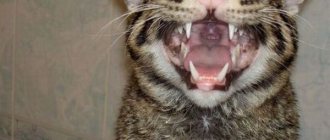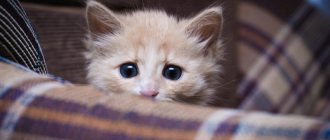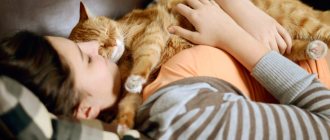History of the origin of the Balinese cat breed
The ancestors of the Balinese are Siamese, which can be clearly seen in their appearance. The first Siamese kitten with long hair was registered in 1928-1929 in America. Until this point, all long-haired Siamese were sold for next to nothing, excluding their breeding. The origin of such cats is due to a genetic mutation. However, the history of development was changed by 2 female breeders.
Interesting!
At first the cats were called Siamese longhairs. Later they were nicknamed Balinese in honor of the dancers in Bali, who resembled cats with their bright appearance and smooth movements.
They received their first official recognition in the 70s of the 20th century, when they were registered by the CFA and TICA organizations. Marion Dorset, who was later joined by Helen Smith, began breeding unusual kittens. From America, cats began to be imported to Europe, from where they arrived in the CIS countries in 1988.
Interesting!
In the CIS countries, Siamese cats are mistakenly considered angry and aggressive, which is wrong. They were originally bred as calm companions for families with children.
Appearance of the Balinese breed
The Balinese cat breed looks like a Siamese longhair. In general, the description corresponds to a standard medium-sized cat, but with a more elongated muzzle and slanted eyes.
Interesting!
Animal allergies are a common reason for giving up cats. The Balinese have succeeded here too. The saliva of the Balinese breed has a reduced concentration of protein, which causes allergies. This makes them hypoallergenic.
Height and weight
A cat aged 1-2.5 years weighs 2.5-5 kg. We can talk about the final weight at the age of 2-3 years. Until this moment, the animal continues to gain weight. Especially rapidly at the age of 1 year.
The height at the withers is on average 24-25 cm.
Length and shape of limbs
The legs are long and graceful. The rear ones are slightly shorter than the front ones. The shape of their end is oval. The toes are well separated and elongated.
The tail is long and straight. The thickness is the same along the entire length. Balinese cats often have kinks in their tails.
Head
The muzzle is long, narrow, extended forward. This breed often has heads that have the shape of an elongated wedge. The bite is correct.
The nose is elongated, there is no stop (the stop is a pronounced bend of the bridge of the nose). The ears are very large and have the shape of a triangle.
Eye color and shape
Kittens' eyes remain blue even as they grow older. The setting of the eyes creates the feeling of a sad but meaningful look. The outer corner is turned up, which visually makes the look slanted.
The eyes are set close, the distance between them corresponds to the width of the eye.
Interesting!
The more saturated the shade of the eyes, for example, deep blue, violet, the more valuable the representative of the breed.
Wool
The breed is long-haired. There is no undercoat, which eliminates an allergic reaction to the animal. The fur fits tightly to the skin. It feels silky and soft to the touch. The hairs are quite thin and of medium length. The fur on the tail and neck area curls slightly. There must be a plume at the tip of the tail - a flowing tassel consisting of longer hair.
Interesting!
In order for the offspring to develop long fur, both parents must be long-haired. It was thanks to the crossing of long-haired individuals that the Balinese breed arose.
At birth, hypoallergenic kittens have no hair, which is also safe for people with allergies to cats. Gradually, their light fur grows, which only after a few months acquires the Siamese color. The full picture can be seen at 3 years old. With age, the overall light shade becomes darker, which is normal for this breed.
Constitution
The Balinese cat has a medium body size. The breed is characterized by thinness and an elongated body. Their shoulder blades and sacrum are clearly visible. The belly is tucked in and does not hang like the British. Despite their apparent weakness, cats have great strength.
Voice
Pets are very talkative. They can be indignant for a long time and tell the owner something. It is important to pay attention to the animal in return, talk to it, then they will be happy. The pet is not suitable for those who like silence.
Important!
The animal is not suitable for people who are not at home. The pet will quickly become depressed. In this case, it is better to buy a partner for the cat.
Cats' voices are calm and melodic, the sounds they make are more reminiscent of conversation rather than meowing.
Lifespan
If the animal is in good health, and the owner regularly takes the pet for checkups, then the Balinese will live up to 14-16 years. Average life expectancy is 12 years. There are rare individuals that live up to 20 years.
Possible defects
Defects do not affect the health of the pet, but exclude the possibility of participation in exhibitions, and sometimes even in breeding.
The Balinese have:
- strabismus;
- light shade of the iris;
- creases on the tail;
- red, black colors;
- lack of color marks on the nose and paws;
- excessively dark body color;
- incorrect bite or overly pronounced chin;
- the presence of light spots on the fur is also considered a defect.
Important!
Strabismus in Balinese is a cosmetic problem. It does not affect the health, behavior, or mood of the pet.
Health
This cat breed, like the Siamese, has various genetic diseases, including:
- amyloidosis is a disease in which protein metabolism in the body is disrupted. First of all, the animal’s liver may suffer from it;
- asthma;
- congenital heart defects such as aortic stenosis;
- strabismus;
- diseases of the esophagus such as megaesophagus;
- hyperaesthetic syndrome, in which cats over-groom their fur, causing it to fall out;
- lymphoma;
- nystagmus is a neurological disorder that causes involuntary and rapid eye movements;
- progressive retinal atrophy.
Coat color
The Balinese cat has a pointing coat color, which can be seen in the photo below. The bulk of the body is always light beige or coffee-with-lait. The ears, paws, mask on the face and tail are highlighted in a dark shade.
Red and black shades are excluded. Only a few types of colors are recognized.
Seal point
The main coat color is light beige with a warm undertone. The muzzle, paws, ear area and tail are highlighted with a gray or dark brown palette.
Blue point
The main shade of the fur has a cold undertone, the fur is grey-blue, but remains light. The nose is highlighted in grey. The area of the muzzle, paws and tail is marked in gray, which is clearly visible in the photo.
Frost point
This is a light color. The body has an almost snow-white tint. The point area is colored beige or ivory. Color descriptions are rarely seen on notice boards because... These light ones sell out quickly.
Chocolate point
The bulk of the wool is colored the color of baked milk. The markings are highlighted with a chocolate tint, which is well conveyed by the photograph.
Interesting!
The cat is considered hypoallergenic, which is a big plus for cat lovers with animal allergies.
Some phenological organizations recognize the following colors: tabby (stripes on the body), red (red points).
Characteristics and habits
This is one of the most sociable, intelligent and kind breeds.
Interesting!
Cats with bad temperament are excluded from further breeding. Therefore, among the Balinese there are no hissing, scratching animals.
Attitude towards people and children
They do not run away from kids, cats are friendly to children and show sincere interest in them.
They trust the owner. They remain faithful to him until the end of their days. Tend to read emotions. They can easily support the owner if he is sad or rejoice with him.
Intelligence
The Balinese is a fairly highly intelligent, intelligent and well-mannered breed. They do not create a mess, do not bother people, and do not offend children and small animals.
The cat is inclined to analyze events, draw conclusions, adapt to the owners, their tastes and requirements. If you hide a treat or favorite toy from them, they can easily track its location. Prefers to spend time near people.
Interesting!
Breeders believe that the intelligence of a Balinese cat is identical to that of a 3-4 year old child.
Sociability
Balinese cats are not the kind of cats that come to people for a portion of food. They need a daily dose of communication and hugs. They prefer to rest and sleep next to their owner or in his arms.
Cats get along well with other pets, dogs and cats. If they steal a piece of food, they will gladly share it with a friend.
Animals love to be cuddled, held in arms, and paid attention to. Cats often show their feelings in return.
Important!
The breed loves to be the center of attention and cannot stand being alone. If she lacks love, she can play pranks.
Education and training
Cats are easy to train. They quickly remember basic commands. They are easy to train to a litter box, a sleeping, resting and feeding area. The breed also rarely marks territory.
It is necessary to educate the Balinese, because... cats are very active. They are able to walk on a leash, but in general they feel good in an apartment.
Interesting!
Pets easily jump onto high surfaces, for which they are nicknamed acrobats.
Lack of aggression
This is the main feature of the Balinese breed. Cats generally do not like to hiss, bite and scratch. Therefore, they get along well with children and other animals.
Also, the animal has no instinct of self-preservation. The animal easily climbs onto window sills and balconies and is not at all afraid of menacing dogs. Therefore, the owner should secure the apartment, not leave the windows open, and keep an eye on the animal.
Buying a Balinese kitten: how to choose, where is the best place to buy
Despite the fact that Balinese are considered a rather rare breed, on the Internet you can easily find a good deal at an affordable price. However, in this case, no one will provide quality guarantees. In order not to regret your choice, you should contact professional breeders in a nursery with a good reputation.
Breeders of Balinese cats
Responsible breeders usually sell kittens from 12 weeks of age. By this time, they will be vaccinated, socialized and will be able to calmly move to a new home. A decent breeder will under no circumstances hide either his name or his identity and will definitely provide information about the organization and the international felinological association in which he is registered.
Buying Balinese kittens
Balinese catteries
In order not to make a mistake in choosing a pet, you should only contact nurseries that raise purebred Balinese. Unfortunately, there are not many of them.
When buying a kitten, you need to carefully examine it. The main sign of a good young animal is its fur; it should be very fluffy.
Note! The kitten will acquire a full coat, as well as color, only six months after birth.
How much does a Balinese kitten cost?
As a rule, a real purebred Balinese kitten costs at least 250 dollars*. This amount is fully correlated with the cost of raising the animal and preparing it for moving to a new home. It is also worth considering the costs of food, medical care, vaccinations, as well as maintaining comfortable living conditions.
Balinese cats adapt well to any family. However, if there are small children in it, you need to make sure that they do not squeeze the animal or drag it by the tail. Although representatives of this breed are quite patient and love to play with children, they will not tolerate disrespectful treatment and, if offended, can use their claws.
*Prices are as of August 2021.
Care and maintenance
Animal care is standard; maintenance does not require large financial investments. Thanks to the absence of undercoat, owners are freed from a good portion of fur flying around the house.
Moving into a new home
The animals in the new territory are provided with comfortable living conditions:
- It is important to immediately install a high-quality scratching post that is comfortable for the cat. Show your pet where to sharpen its claws. A scratching post can be part of a large play complex.
- Place a tray suitable for the size of the cat. Small trays with low sides are temporarily purchased for kittens so that they can climb into them. The filler is changed every 2-3 days. Place the tray in a quiet, secluded place that is always accessible.
- The food area must be equipped with clean drinking water, which is changed daily. Dry food is placed nearby.
- The sleeping area should be equipped with a warm blanket or bed.
- It is important to have a variety of toys - balls, mice, rattles, etc. This makes it easier to come up with a game with cats, or occupy it in a separate room.
Important!
The animal often freezes due to the lack of undercoat. Balinese cats should not be walked with in cold weather. It is necessary to protect them from drafts and open windows. Comfortable climate 22-25 °C.
Hygiene and medical procedures
List of procedures:
- The main advantage of the Balinese cat is the absence of undercoat. There is less excess hair, but the animal needs to be combed regularly - once a week. Otherwise, the fur will get tangled and roll up.
- The corners of the eyes are cleaned of accumulated dirt every 1-3 days. Use a cotton swab dipped in boiled water or chamomile decoction.
- It is important to clean the ears every 2 weeks. Sulfur and dust accumulate inside. Use a damp cotton pad.
- Nails are trimmed every 1-2 weeks, even if the cat uses a scratching post. At home, claws grow quickly, curling up and injuring the delicate paw pads. The procedure also protects the interior and upholstered furniture that cats love to scratch.
- Regular brushing of teeth with a special paste is not a mandatory procedure. It protects against gum and dental problems that Balinese cats are prone to.
- Also, every quarter the animals are given an anthelmintic drug that protects them from parasites.
- At the 3rd month of life, the first vaccinations are given, and revaccination is carried out once a year.
Diet
Balinese are not picky. They will eat whatever their owner gives them.
Feeding is carried out 3-4 times a day. Kittens and cats under 2 years of age have a better appetite than adults. For cats over 3 years old, 2 meals per day are enough.
It is easier for the owner to buy industrial feed. They calculate norms and proportions and take into account the necessary vitamins. It is better to buy holistic food, then the animal’s health will not be threatened.
Popular brands:
- Power of Nature;
- Wellness CORE;
- Eukanuba;
- Golosi.
Seasonally, mineral supplements, vitamins, and fresh grass are added to the feed.
Some owners prefer to organize a natural menu.
It is acceptable to give:
- fresh dietary meat and fish, pre-frozen and treated with boiling water, make up 80% of the diet;
- boiled egg;
- greenery;
- boiled or raw vegetables;
- boiled cereals;
- dairy products.
Important!
Porridge and vegetables are not the cat's favorite foods. Children are taught a healthy diet from an early age. You can't feed them from the table. Cats do not digest highly salted, smoked, sweet or fried foods.
Caring for Balinese cats
Some potential cat buyers refuse the Balinese breed because of the length of the animal's coat, which requires increased care. But since the Siamese Balinese coat does not have an undercoat, it does not require any special care. It will be enough to brush your pet's fur weekly with a special slicker brush (every day during the molting period).
Note! If the procedures for removing excess hair are very irregular, then for preventive purposes the animal can be given special food for removing hair.
You should bathe your cat up to once a month, using special shampoos and conditioners. Cleaning your eyes, ears and teeth should be done at least once a week. A cotton pad soaked in warm water is perfect for wiping your eyes. It is advisable to buy specialized food for teeth. Claws are usually trimmed once a month with a special scratching post.
Caring for Balinese cats
What to feed Balinese cats
Representatives of the Balinese breed are very picky when choosing food, so there should be no problems with nutrition. The cat can be fed both commercial food and home-prepared natural dishes. The main rule is not to mix different types of cat food.
Hereditary diseases
The breed does not have specific diseases, because has good heredity. In rare cases, they develop diseases that are common to all cats.
Amyloidosis is hereditary
This is a hereditary disease associated with a disorder of protein metabolism. Amyloids accumulate in the kidneys, the body stops forming urine, which is why the organ releases primary urine into the external environment.
Symptoms of kidney amyloidosis are problematic digestion, poor skin and fur, lightened stool, decreased appetite and apathetic mood.
Important!
Cats over 7 years old are at risk. The disease may develop against the background of severe poisoning.
Dilated cardiomyopathy
The disease is associated with poor functioning of the ventricles of the heart, which often provokes heart failure. The myocardial walls become thinner, and the volume of the ventricles increases.
Symptoms include rapid breathing, apathy, arrhythmia, and lung sounds.
Important!
Cats over 5 years old are at risk.
Gingivitis
Balinese cats in general often suffer from dental problems, so their oral hygiene requires special care. Description of symptoms: refusal of food and water, red swollen gums, bad breath, excessive salivation, lethargy of the animal.
If the owner discovers inflamed gums in a pet, you should immediately contact a veterinarian. Otherwise, the risk of developing abscesses and even tooth loss increases.
Diabetes
The danger of the disease is that it is difficult to detect in the early stages.
First symptoms:
- strong thirst;
- constant and frequent urination;
- apathy and lethargy of the animal;
- rapid weight gain or sudden weight loss.
Character
Siamese and Balinese may differ in the length of their coats, but underneath they are identical. Balinese people love their family very much. They love to be “helpful” and will watch your every move. As soon as the owner sits down, the Balinese will immediately climb onto his lap, and at night he will also not leave his person alone, but will most likely crawl under the blanket and put his head on the pillow.
This cat will get underfoot a lot, so it may not be the best choice for people who are unsteady on their feet or who use aids (such as canes) to get around. The Balinese may not be as boisterous as their Siamese cousins, but they are definitely just as stubborn. Your pet will definitely remind you that it needs attention. You can also count on him to "tell everything" to guests, so be grateful that most people don't know cat language.
Balinese are very intelligent, active and athletic animals who love to play. The pet must always be busy with something. Puzzle toys will help with this, as well as games in which the cat can chase. A large tree is a great way for a cat to stay fit.
This animal can walk on a leash and easily learns various tricks. Never leave your pet alone without any entertainment, otherwise you risk a trashed house. If you like to chat with someone during the day, Balinese can be your best friend. Just make sure you have time to pay attention to this demanding and social cat. Balinese people don't mind staying at home during the day while you go to work, but they expect you to pay attention to them when you get home.
To prevent your pet from feeling sad alone, a great option would be to get another Balinese. This loyal and loving cat, given the right conditions, can make a great friend.
Choosing a kitten, cost
Finding a nursery with Balinese dogs is not so easy. In Russia there are only 10-12 nurseries aimed at breeding them, some of them are closing.
Balinese cat kittens are white, so to make sure the breed is purebred, it is important to see the baby's parents. They also ask to see the pedigree and vaccination passport. The kitten must be active and friendly.
If you take a kitten without documents or with minor defects, it will cost 20,000 rubles. For breeding, they represent more presentable individuals, costing from 30,000 rubles.
Breeding a Balinese cat
The breed is difficult to breed because... Crossing the same Balinese with each other is harmful to the health of cats. After 4-5 generations of purebred Balinese, the typical characteristics begin to degenerate.
The Balinese cat is allowed to be mated with Siamese cats, Seychelles cats and longhaired Orientals.
Interesting!
Kittens are born without fur. It increases as you grow. The Siamese color also does not appear immediately; at first the fur is white.
Puberty in kittens begins at the age of 9-10 months. The first mating is carried out at 1.5 years. You can't rush, because... Kittens under 1 year of age have not yet developed their bodies.
Photo and video
Photo:
Video:
Video: Balinese. Balinese cat breed.
Video: Balinese (Balinese) or Balinese cat
The breed has a lot of advantages in the form of a friendly character, easy care and calm disposition. This is the best friend for allergy sufferers, families with children and people who want a talkative companion.
Characteristic
The main qualities and features of the Balinese cat breed on a 10-point scale:
- family attachment 8/10
- shedding intensity 6/10
- general health 4/10
- playfulness 8/10
- tendency to vocalize 2/10
- good attitude towards children 8/10
- good attitude towards strangers 8/10
- ease of care 8/10
- friendliness to other pets 8/10

